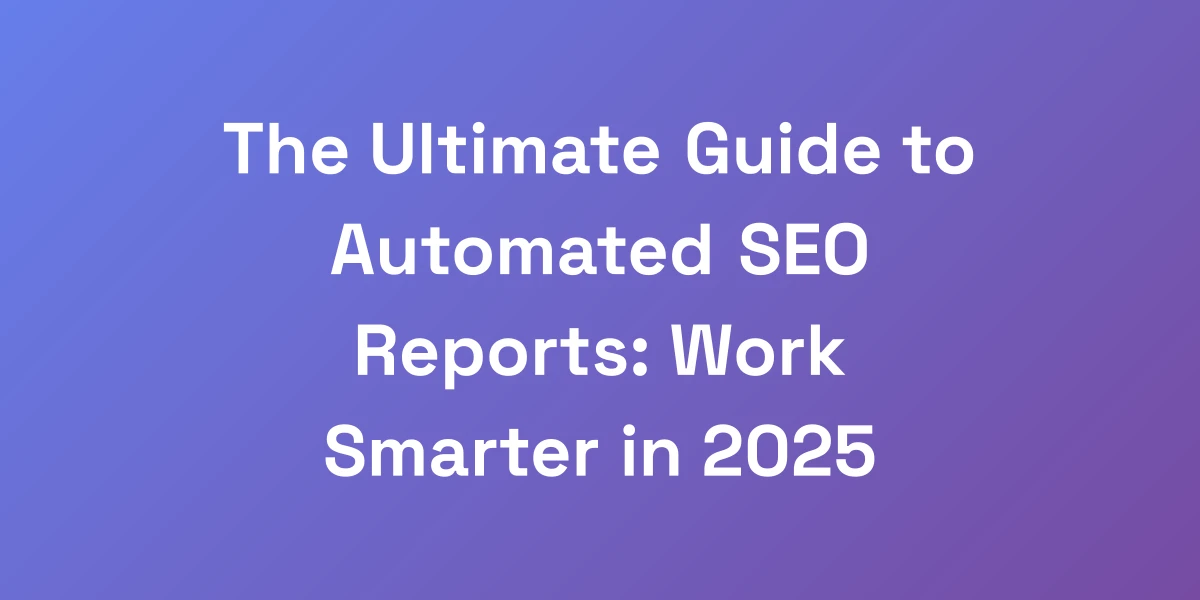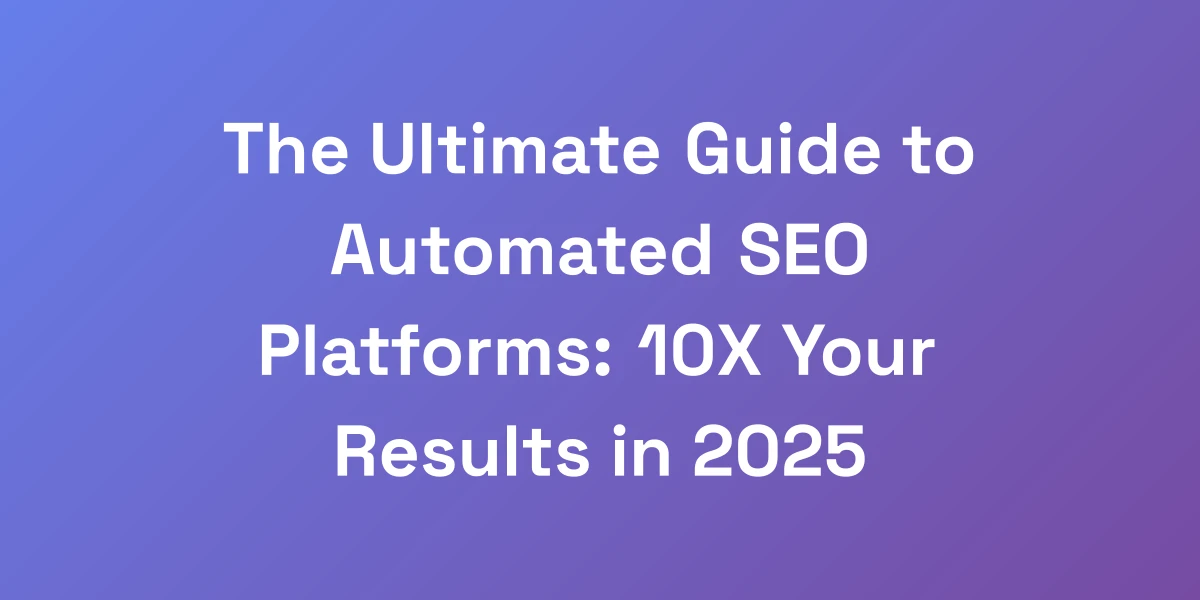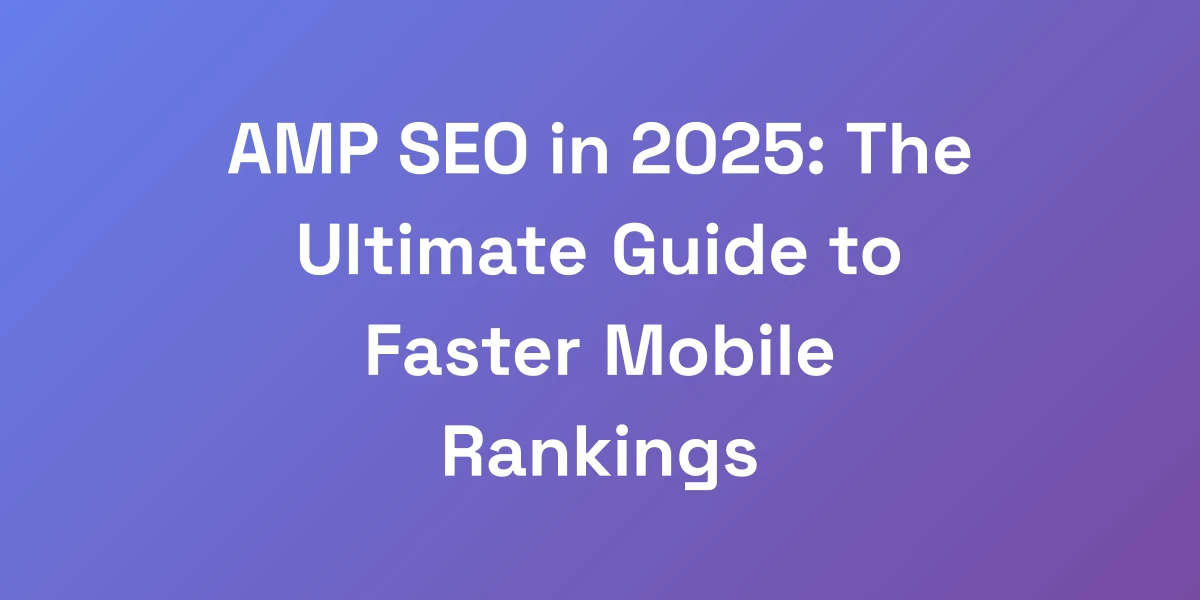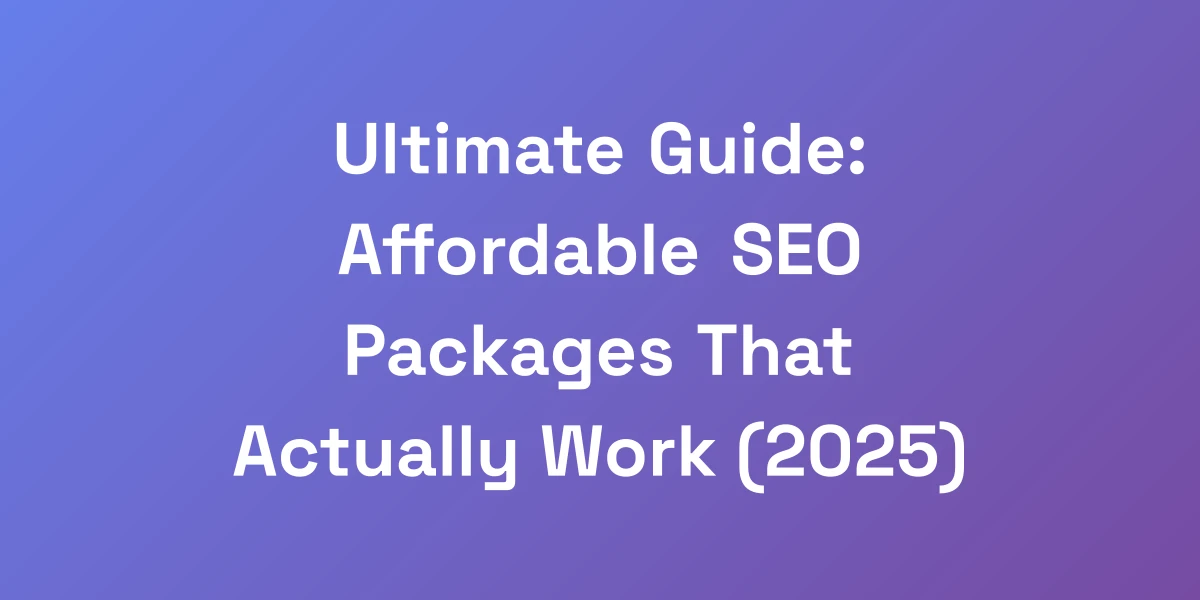
The Ultimate Guide to Automated SEO Reports: Work Smarter in 2025
Feb 25, 2025 | By [email protected]
Introduction
Imagine reclaiming the countless hours you’ve spent slogging through spreadsheets and manual data collection. Sounds too good to be true, right?
But what if I told you there’s a way to automate your SEO reporting, freeing you up to focus on what truly matters – crafting strategies that drive real results?
In this guide, we’re diving deep into the world of automated SEO reports. We’ll tackle the challenges you face with traditional reporting methods and unveil how automation isn’t just a time-saver but a game-changer for your SEO strategy.
Ready to transform your workflow and make data-driven decisions that propel your business forward? Let’s explore how automated SEO reports can help you work smarter in 2025.
Understanding the Power of Automated SEO Reporting
Let me be real with you – I used to spend countless hours manually compiling SEO reports, and it was honestly soul-crushing.
That’s until I discovered the game-changing world of automated SEO reporting.
In this section, we’ll explore how these powerful tools have transformed the way we track and analyze SEO performance.
I’ll share my personal journey from spreadsheet hell to automated heaven, and show you why this shift isn’t just about saving time – it’s about making better, data-driven decisions that actually move the needle.
What Are Automated SEO Reports?
At its core, an automated SEO report is a system that collects, analyzes, and presents your SEO data without the need for constant manual input.
Think of it as your personal SEO assistant, tirelessly gathering metrics from various sources and compiling them into coherent, actionable reports.
These reports can include everything from keyword rankings and backlink profiles to site audits and traffic analysis.
The key here is automation – allowing these reports to update in real time, providing you with the most current data.
The Evolution of SEO Reporting
SEO reporting has come a long way from the days of basic Excel sheets and manual data entry.
Initially, SEO professionals relied heavily on manual processes, which were not only time-consuming but also prone to errors.
As the digital landscape evolved, so did the tools. The introduction of sophisticated software has revolutionized how we approach SEO reporting.
Today, automated tools can seamlessly integrate with your existing platforms, pulling data from multiple sources and presenting it in an easy-to-understand format.
This evolution has made it possible to track more metrics, gain deeper insights, and respond to changes in real time. For a comprehensive list of SEO reporting tools, check out Coefficient.io.
Key Benefits of Automation in SEO
Automating your SEO reporting brings a myriad of benefits that go beyond just saving time.
- Efficiency: Automation reduces the time spent on data collection and report generation, allowing you to focus on strategic planning.
- Accuracy: Automated systems minimize human error, ensuring that your data is precise and reliable.
- Real-Time Insights: Get up-to-the-minute data, enabling quicker responses to SEO trends and changes.
- Scalability: Easily manage and report on multiple websites or campaigns without increasing your workload.
- Customizability: Tailor reports to suit different stakeholders, whether it’s for clients, team members, or executives.
These benefits collectively enhance your ability to make informed decisions that drive SEO success.
Common Myths and Misconceptions
There are numerous myths surrounding automated SEO reporting that can deter businesses from embracing it.
- Myth 1: Automation lacks the personal touch of manual reports.
- Myth 2: Automated reports are impersonal and not customizable.
- Myth 3: Setting up automated reports is too complex and time-consuming.
Let’s debunk these myths:
- Myth 1 Debunked: Automated reports can be highly personalized, including specific metrics that matter most to your business.
- Myth 2 Debunked: Modern tools offer extensive customization options, allowing you to tailor reports to different audiences.
- Myth 3 Debunked: With the right tools and guides, setting up automated reports is straightforward and quick.
Understanding the truth behind these misconceptions can lead to a more effective and efficient SEO strategy.
Real-World Impact on Business Growth
Businesses that have embraced automated SEO reporting have seen significant improvements in their SEO performance and overall growth.
For example, an agency that switched to automated reports freed up 20 hours a month previously spent on manual reporting, similar to strategies outlined in digital marketing for agencies.
This extra time was redirected towards strategic activities like content creation and link building, leading to a 30% increase in client ROI.
Another case study showed a company using automated reporting tools was able to identify and rectify technical SEO issues faster, resulting in a 25% boost in organic traffic within six months.
These real-world examples, including those from financial services, highlight the transformative power of automation in driving business growth through enhanced SEO strategies.
Essential Components of an Automated SEO Report
Through years of experimentation and countless conversations with top SEO professionals, I’ve identified the crucial elements that make an automated SEO report truly valuable.
Think of this as your reporting framework blueprint. We’ll dive deep into each component, exploring not just what to track, but why it matters and how to interpret the data.
I’ll show you exactly how I structure my reports to maximize insights while minimizing noise, ensuring every metric serves a purpose in your SEO strategy.
Core SEO KPIs You Must Track
Key Performance Indicators (KPIs) are the backbone of your SEO reports. They provide measurable values that demonstrate how effectively your SEO strategies are achieving business objectives.
- Organic Traffic: The number of visitors coming to your site through organic search. It’s a direct indicator of your SEO efforts’ effectiveness, as highlighted in the State of Organic Marketing report.
- Keyword Rankings: Tracking where your site ranks for targeted keywords helps you understand the visibility of your content.
- Backlinks: The number and quality of backlinks to your site influence your authority and search rankings.
- Click-Through Rate (CTR): The percentage of users who click on your link after seeing it in the search results. It indicates how compelling your titles and meta descriptions are.
- Conversion Rate: The percentage of visitors who complete a desired action, such as making a purchase or filling out a form. This ties SEO performance directly to business outcomes.
Additionally, tracking your presence in best local business directories can significantly influence your local SEO performance.
Focusing on these core KPIs ensures you’re tracking the metrics that truly matter.
Advanced Metrics for Deeper Insights
While core KPIs provide a foundation, advanced metrics offer deeper insights into your SEO performance.
- Domain Authority (DA): A score that predicts how well your website will rank on search engines based on the quality and quantity of backlinks.
- Page Load Speed: Faster-loading pages provide a better user experience and can positively impact your rankings.
- Bounce Rate: The percentage of visitors who leave your site after viewing only one page. A high bounce rate may indicate irrelevant content or poor user experience.
- Indexed Pages: The number of your site’s pages that are indexed by search engines. Ensuring all important pages are indexed is crucial.
- Mobile Usability: With the majority of searches now happening on mobile devices, ensuring your site is mobile-friendly is essential.
Incorporating these advanced metrics can uncover hidden opportunities and areas for improvement.
Customization Options for Different Stakeholders
Different stakeholders have varying needs when it comes to SEO reports. Customizing your reports ensures that each audience, such as content marketing for small businesses, receives the information most relevant to them.
- Executives: Focus on high-level metrics like overall traffic, conversion rates, and ROI. They’re interested in how SEO contributes to business goals.
- Marketing Teams: Detailed data on keyword performance, content success, and competitor analysis. They need insights to refine marketing strategies.
- Clients: Clear, understandable reports that highlight key achievements, progress, and areas for improvement without overwhelming technical details.
By tailoring your reports, you ensure that each stakeholder can quickly grasp the information that’s most important to them.
Data Visualization Best Practices
Presenting data in a clear and visually appealing manner is crucial for effective reporting.
- Use Charts and Graphs: Visual representations like bar charts, line graphs, and pie charts make complex data easier to understand at a glance.
- Simplify Design: Avoid clutter by using clean, simple designs. Focus on the most important data points and use whitespace effectively.
- Consistent Styling: Maintain consistency in colors, fonts, and styles to make reports look professional and cohesive.
- Highlight Key Metrics: Use colors or bold text to emphasize critical metrics, making it easier for readers to focus on what’s most important.
Effective data visualization transforms raw data into actionable insights, enhancing the report’s overall impact.
Automated Alert Systems and Triggers
One of the standout features of advanced SEO reporting tools is the ability to set up automated alerts and triggers.
- Performance Drops: Receive instant notifications if a key metric, like organic traffic or keyword ranking, drops unexpectedly.
- Achievement Milestones: Get alerts when you hit significant milestones, such as reaching the top 10 rankings for a target keyword.
- Technical Issues: Automated systems can flag technical SEO issues like broken links or slow page speeds as soon as they occur.
These alerts ensure you’re always informed about critical changes, allowing for quick action to maintain or improve your SEO performance.
Top Tools for Automated SEO Reporting in 2025
Having tested dozens of SEO reporting tools over the years, I’ve developed a keen understanding of what makes certain platforms stand out.
In this section, I’ll share my unfiltered opinions on the best automated SEO reporting tools available today.
We’ll explore everything from budget-friendly options to enterprise-level solutions, focusing on how each tool can fit into your specific workflow and requirements.
I’ll even reveal my personal tech stack and the exact setup I use for my own projects.
Comprehensive Tool Comparison Matrix
To simplify your decision-making process, here’s a comparison matrix of some top SEO reporting tools:
| Tool | Best For | Key Features | Price Range |
|---|---|---|---|
| Ahrefs | Comprehensive SEO Analysis | Backlink analysis, keyword explorer, site audits | $99 – $999/month |
| Semrush | All-in-One Marketing | Keyword tracking, competitor analysis, content optimization | $119.95 – $449.95/month |
| StoryChief | Content-Centric Reporting | Content performance metrics, multi-channel distribution | $79 – $299/month |
| Coupler.io | Flexible Data Integration | Custom integrations, automated data blending | $29 – $499/month |
| SE Ranking | Budget-Friendly Solutions | Keyword rank tracking, backlink analysis, competitor research | $39 – $349/month |
This matrix provides a snapshot of what each tool offers, helping you identify which one aligns best with your needs.
Integration Capabilities and APIs
Integration is key when it comes to automated SEO reporting tools. You want a tool that seamlessly connects with your existing platforms and data sources.
- Google Analytics: Essential for tracking traffic and user behavior metrics. Most tools offer robust integrations with Google Analytics.
- Google Search Console: Vital for monitoring keyword performance and technical SEO issues. Ensure your tool can pull data directly from Search Console.
- CRM Systems: Integrating with your CRM can provide insights into how SEO efforts translate into sales and leads.
- CMS Platforms: Direct integrations with WordPress, Shopify, or other CMS platforms can streamline data flow and reporting.
- APIs: For more customization, check if the tool offers a comprehensive API that allows for bespoke integrations tailored to your specific needs.
Choosing a tool with strong integration capabilities ensures your reporting is comprehensive and cohesive.
Pricing and Value Analysis
When selecting an automated SEO reporting tool, balancing cost with value is crucial.
- Budget-Friendly Options: Tools like Coupler.io and SE Ranking offer excellent features at more affordable prices, making them ideal for small to medium-sized businesses.
- Mid-Tier Solutions: Platforms like StoryChief and Semrush provide a broader range of features, suitable for growing businesses requiring more comprehensive reporting.
- Enterprise-Level Tools: Ahrefs excels in large-scale SEO analysis and is perfect for agencies and enterprises willing to invest more for extensive features and data capacity.
Consider not just the upfront costs but also the potential return on investment. A more expensive tool might save you more time and provide deeper insights, ultimately delivering better value.
User Experience and Learning Curve
The ease of use plays a significant role in how effectively you can utilize an SEO reporting tool.
- Intuitive Interfaces: Tools like Semrush and StoryChief are known for their user-friendly interfaces, making it easier for teams to adopt and use them effectively.
- Learning Resources: Comprehensive tutorials, webinars, and customer support can significantly reduce the learning curve. Ensure the tool you choose offers robust support materials.
- Customization Flexibility: Depending on your needs, you might require a tool that offers extensive customization options, which can sometimes complicate the user experience.
Choosing a tool that aligns with your team’s technical proficiency ensures smooth implementation and ongoing usage.
Future-Proofing Your Tool Selection
SEO is an ever-evolving field, and your reporting tools need to keep pace with the changes.
- Regular Updates: Opt for tools that frequently update their features to adapt to the latest SEO trends and algorithm changes.
- Scalability: As your business grows, your tool should scale with you, handling more data and more complex reporting needs without a hitch.
- AI Integration: Leveraging AI and machine learning can provide predictive analytics and deeper insights, ensuring your SEO strategy stays ahead of the curve.
Selecting a tool that’s built to evolve ensures your reporting remains relevant and effective in the face of changing SEO landscapes.
Setting Up Your First Automated SEO Report
Let’s get practical. I’ll walk you through the exact process I use to set up automated SEO reports that actually deliver value.
This isn’t just theory – it’s a step-by-step implementation guide based on real experience.
We’ll cover everything from initial setup to advanced customization, ensuring you can create reports that not only save time but also provide actionable insights for improving your SEO performance.
I’ll even share some of my favorite automation recipes that you can implement today.
Initial Setup and Configuration
Start by selecting the right tool from our previous comparison. For this example, let’s use Semrush.
- Create an Account: Sign up for a Semrush account and choose a plan that fits your needs.
- Connect Your Data Sources: Link your Google Analytics and Google Search Console accounts to Semrush for seamless data integration.
- Set Up User Permissions: Define who in your team has access to the reports and what level of access they require.
Data Source Integration Guide
Integrating your data sources accurately is crucial for comprehensive reports.
- Google Analytics Integration: Ensure Semrush is pulling data on Organic Traffic, Bounce Rate, and Conversion Rates.
- Google Search Console Integration: This will provide insights into Keyword Rankings and Search Performance.
- CRM Integration: If applicable, integrate your CRM to track how SEO efforts are converting into leads and sales.
Double-check each connection to ensure data is flowing correctly and consistently.
Custom Report Templates
Creating custom templates allows your reports to align with specific goals and stakeholder needs.
- Executive Summary: A high-level overview highlighting key metrics and achievements.
- Detailed Analysis: In-depth sections breaking down each KPI, complete with charts and graphs.
- Actionable Insights: Specific recommendations based on the data, guiding future SEO strategies.
Most tools, including Semrush, offer pre-built templates that you can customize further to suit your needs.
Automation Workflows and Triggers
Setting up automation workflows ensures your reports are generated and delivered without manual intervention.
- Scheduling: Determine how frequently you need reports – weekly, monthly, or quarterly – and set up automated schedules accordingly.
- Triggers: Define specific events that will trigger an immediate report, such as a significant drop in organic traffic or a spike in keyword rankings.
- Delivery: Configure the delivery method, whether it’s email, Slack notifications, or integration with other tools like Trello or Asana.
By automating these workflows, you ensure consistent and timely reporting without the back-and-forth of manual processes.
Quality Control and Testing
Before fully relying on your automated reports, it’s essential to implement quality control measures.
- Initial Review: Compare automated reports against manually generated ones to ensure accuracy.
- Data Validation: Regularly check the data sources to confirm they’re pulling the correct information.
- Feedback Loop: Gather feedback from stakeholders to refine and improve the report templates and data presented.
Implementing these steps ensures your automated reports are reliable and trusted by all stakeholders.
Advanced Strategies for Maximizing Report Value
After mastering the basics, it’s time to elevate your reporting game.
I’ve discovered several advanced techniques that can transform good reports into exceptional ones.
We’ll explore how to leverage AI and machine learning for predictive insights, create custom algorithms for better data analysis, and implement advanced visualization techniques that make your reports stand out.
These are the strategies that have helped me consistently deliver outstanding results for my projects and clients.
AI-Powered Analysis Techniques
AI can revolutionize how you interpret and utilize your SEO data.
- Predictive Analytics: Use AI to forecast future trends based on historical data, helping you stay ahead of the competition. For insights, refer to the AI SEO Benchmark Report.
- Content Optimization: AI tools can suggest content improvements by analyzing keyword usage, readability, and engagement metrics.
- Automated Insights: Let AI highlight significant changes or patterns in your data that might be missed in manual analysis.
Integrating SEO automation ensures your reports are not only data-rich but also insightful and forward-thinking.
Custom Scoring Systems
Developing custom scoring systems can provide a more nuanced view of your SEO performance.
- SEO Health Score: Combine various metrics like site speed, backlink quality, and keyword rankings into a single score that represents overall SEO health.
- Content Performance Score: Evaluate content based on factors such as engagement, social shares, and keyword effectiveness.
- Competitive Score: Compare your SEO performance against key competitors, highlighting areas where you excel or need improvement.
These scoring systems can simplify complex data, making it easier to communicate SEO performance to stakeholders.
Predictive Analytics Integration
Predictive analytics can take your SEO strategy to the next level by anticipating future trends and behaviors.
- Trend Forecasting: Analyze historical data to predict upcoming keyword trends, allowing you to optimize content proactively.
- User Behavior Prediction: Understand how changes in user behavior might impact your SEO performance and adjust your strategies accordingly.
- Algorithm Change Impact: Predict how potential search engine algorithm updates could affect your rankings and prepare mitigation strategies.
By integrating predictive analytics, your reports become tools for strategic foresight, not just reflection.
Advanced Visualization Methods
Effective visualization can turn raw data into compelling narratives.
- Interactive Dashboards: Create dashboards that allow stakeholders to interact with the data, exploring different metrics and timeframes.
- Heatmaps: Visualize where users are clicking or spending the most time on your site to identify areas for improvement.
- Customized Graphs: Use unique graph styles to highlight specific data points or trends that are particularly relevant to your strategy.
Advanced visualization methods make your reports more engaging and easier to understand, enhancing their overall effectiveness.
Automated Insight Generation
Automated insight generation takes reporting a step further by offering actionable recommendations based on the data.
- Optimization Suggestions: Automatically receive tips on improving underperforming pages or enhancing keyword usage.
- Alert-Based Recommendations: Get specific actions to take when certain thresholds are met, such as optimizing content after a ranking drop.
- Trend-Based Insights: Understand overarching trends in your data and receive strategic advice on how to capitalize on them.
These automated insights turn your reports into strategic tools, guiding your actions based on data-driven recommendations.
Conclusion
Automated SEO reports are more than just a convenience – they’re a fundamental shift in how we approach SEO strategy.
By embracing automation, we not only save valuable time but also gain deeper, more accurate insights that drive meaningful results.
From understanding the essential components of a report to selecting the right tools and implementing advanced strategies, this guide has equipped you with the knowledge to transform your SEO reporting.
Now, it’s your turn to take action. Start setting up your automated SEO reports today, and watch as your SEO performance soars.
Have you tried automating your SEO reports? Share your experiences or questions in the comments below – let’s continue the conversation and help each other work smarter in 2025!








